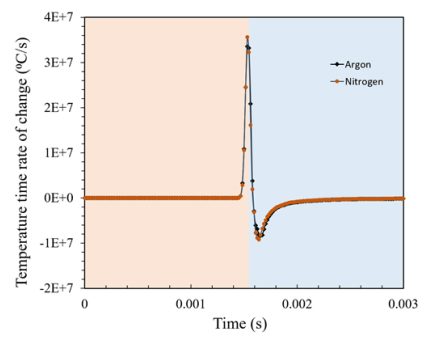
The micro-hardness results of specimens fabricated in Argon and Nitrogen L-PBF atmospheres for the as-built and heat-treated conditions
In a paper entitled “Mechanical Properties of 17-4 PH Stainless Steel Additively Manufactured under Ar and N2 Shielding Gas,” a group of researchers investigates the effect on using either argon or nitrogen as the shielding gas on the final mechanical properties of additively manufactured 17-4 PH stainless steel.
“Many efforts have been done to optimize or improve the mechanical properties of AM parts by investigating various process parameters, scan strategies and building orientation effects,” the researchers state. “Shielding gas has been introduced as another significant parameter which affects not only the thermo-physical but also the mechanical properties of fabricated parts.The shielding gas is responsible for the removal of reactive gases surrounding the melt pool to prevent detrimental effects of reaction with atmospheric gases like oxygen. Various factors such as the base material and chemical-metallurgical reactions of the gas with the melt pool must be considered for choosing the appropriate shielding gas.”
 Effects of various shielding gases such as nitrogen, argon and helium have been studied on the behaviors of different materials such as carbon steels, stainless steels and aluminum alloys. The researchers focus in this study on “modeling the thermal response of 17-4 PH SS by simulating a single track during typical L-PBF conditions while considering convection heat transfer for different shielding gases.”
Effects of various shielding gases such as nitrogen, argon and helium have been studied on the behaviors of different materials such as carbon steels, stainless steels and aluminum alloys. The researchers focus in this study on “modeling the thermal response of 17-4 PH SS by simulating a single track during typical L-PBF conditions while considering convection heat transfer for different shielding gases.”
A numerical study was performed to obtain the temperature, temperature gradient and cooling rates of parts fabricated under argon and nitrogen shielding gases during laser powder bed fusion. Micro-hardness testing and tensile tests were carried out to determine the mechanical performance of the 3D printed parts under the different shielding gases. The following conclusions were reached:
- The nitrogen atmosphere introduces slightly lower temperatures and temperature gradients along tracks while the cooling rate is higher than that of the argon atmosphere. The researchers attribute this to the higher thermal conductivity of nitrogen gas.
- More energy should dissipate from the track to the environment when nitrogen is used as the shielding gas. This is due to the higher cooling rate provided when using nitrogen gas.
- The hardness of specimens fabricated under nitrogen shielding gas is slightly higher than the fabricated specimens under argon gas. This is attributed to the finer microstructure obtained due to the higher cooling rates provided while under the nitrogen atmosphere.
- “The HT-Ar/Ar specimens have higher hardness than HT-Ar/N2 ones. This is due to the higher capability of precipitation hardening in the martensitic microstructure compared to the austenitic matrix as a result of fabricating under Argon atmosphere.”
- There is minimal variation in tensile behavior under all of the tested conditions. However, the specimens 3D printed under the nitrogen atmosphere have slightly higher strength and ductility.
This research may provide valuable insight into how better to avoid defects in additively manufactured parts, such as porosity and lack of fusion. Metal additive manufacturing in particular is a very precise science that involves a great deal of chemical knowledge and mathematical calculations in order to create the optimal conditions for 3D printing. Based on the researchers’ study, manufacturers may be able to alter the conditions under which they 3D print parts, allowing for better overall final components.
Authors of the paper include Pooriya Dastranjy Nezhadfar, Mohammad Masoomi, Scott Thompson, Nam Pham and Nima Shamsaei.
Discuss this and other 3D printing topics at 3DPrintBoard.com or share your thoughts below.
Subscribe to Our Email Newsletter
Stay up-to-date on all the latest news from the 3D printing industry and receive information and offers from third party vendors.
You May Also Like
3D Printing News Briefs, April 13, 2024: Robotics, Orthotics, & Hypersonics
In 3D Printing News Briefs today, we’re focusing first on robotics, as Carnegie Mellon University’s new Robotics Innovation Center will house several community outreach programs, and Ugogo3D is now working...
Rail Giant Alstom Saves $15M with 3D Printing Automation Software 3D Spark
3D Spark has entered into a three-year deal with the rail giant Alstom. Alstom, a transport behemoth with annual revenues of $16 billion, specializes in the manufacture of trains, trams,...
Meltio Expands Global Reach with New Partnerships in the Americas and Europe
Spanish 3D printing manufacturer Meltio has expanded its sales network across the globe. With the addition of three new partners in the United States, Brazil, Argentina, and Italy, Meltio aims...
3D Printing Webinar and Event Roundup: April 7, 2024
Webinars and events in the 3D printing industry are picking back up this week! Sea-Air-Space is coming to Maryland, and SAE International is sponsoring a 3D Systems webinar about 3D...
































